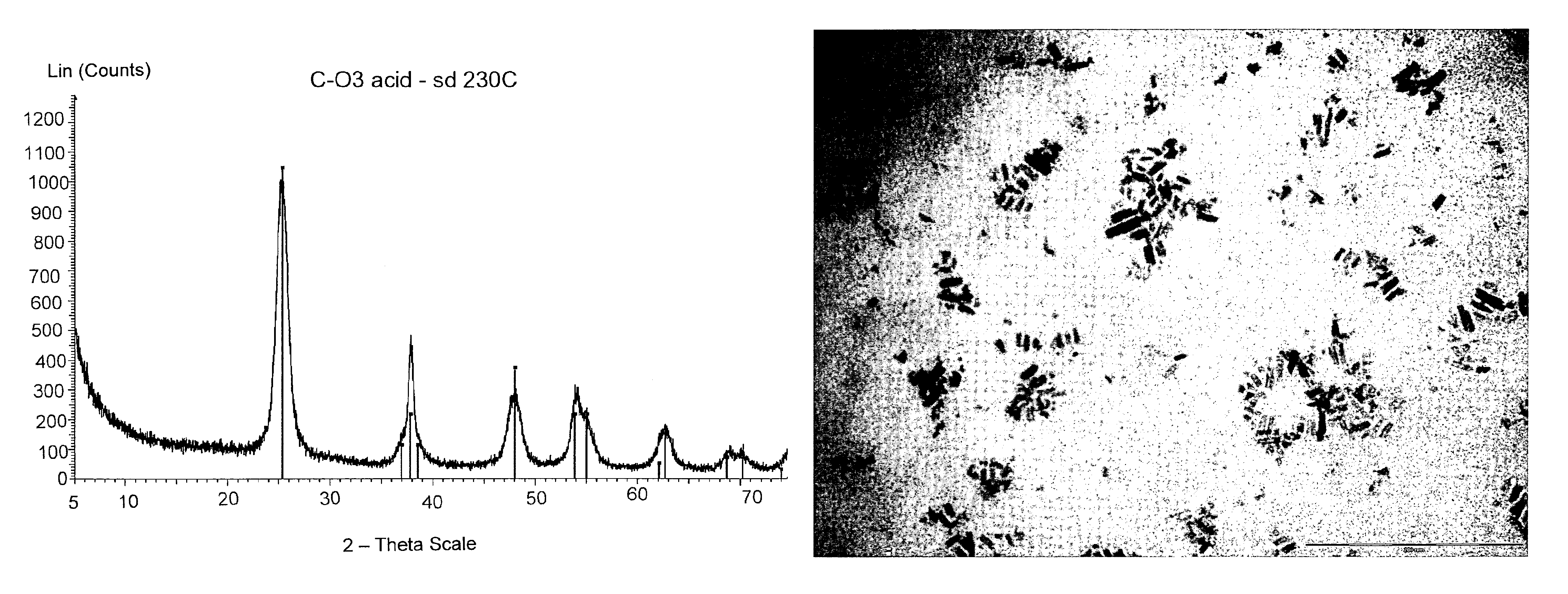Process for the preparation of titanium dioxide having nanometric dimensions and controlled shape
a titanium dioxide and nanometric technology, applied in the field of titanium dioxide preparation with nanometric dimensions and controlled shape, can solve the problems of unsuitable anatase formation methods, laborious process to achieve desired results, and high cost of synthesis methods, and achieves easy industrial scale. , the effect of high reproducibility and economic method
- Summary
- Abstract
- Description
- Claims
- Application Information
AI Technical Summary
Benefits of technology
Problems solved by technology
Method used
Image
Examples
example 1
[0075]Preparation of TiO2 Nanorods (Ester / Alcohol / Neutral Water)
[0076]Benzyl alcohol (81.1 g; 0.75 moles), benzyl acetate (43.25 g; 0.29 moles) and titanium tetraisopropoxide [TIP] (28.43 g; 0.10 moles) are added in sequence at room temperature into a 250 mL three-necked flask equipped with heating and cooling systems, and a magnetic stirrer. The TIP addition causes a slightly exothermic reaction, and the reaction mixture heats up to 40° C. Stirring is started, and heating is applied. Upon reaching the temperature of 80° C., 7.2 mL deionised water are added. The mixture is heated to the reflux temperature (about 100° C.). for 24 hours. Then after cooling to room temperature, the reaction mixture is recovered, further subjected to spay drying (Atomization temperature 230° C.; mixture feeding rate 250 mL / h; drying nitrogen feeding rate: 670 L / h; sucking rate 90 m3 / h) and finally calcinated at 400° C. for 5 min., The TiO2 product thus obtained, having BET surface area 60 m2 / g is charac...
example 2
[0078]Preparation of TiO2 Nanorods (Ester / Alcohol / Acidic Water)
[0079]Benzyl alcohol (81.1 g; 0.75 moles), benzyl acetate (43.25 g; 0.29 moles) and titanium tetraisopropoxide [TIP] (28.43 g; 0.10 moles) are added in sequence at room temperature into a 250 mL three-necked flask equipped with heating and cooling systems, and a magnetic stirrer. The TIP addition causes a slightly exothermic reaction, and the reaction mixture heats up to 40° C. 7.2 mL of HCl 1M are then added at once. The mixture is heated to the reflux temperature (about 100° C.). for 24 hours. After cooling to room temperature, the reaction mixture is recovered, further subjected to spay drying (Atomization temperature 230° C.; mixture feeding rate 250 mL / h; drying nitrogen feeding rate: 670 L / h; sucking rate 90 m3 / h) and finally calcinated at 450° C. for 30 min. The TiO2 product thus obtained, having BET surface area 114.8 m2 / g is characterized by XRPD (FIG. 2a) and TEM (FIG. 2b). The selective formation of nanorods i...
example 3
[0081]Preparation of TiO2 Nanorods (Ester / Acidic Water)
[0082]Benzyl acetate (123 g; 0.82 moles) and titanium tetraisopropoxide [TIP] (28.43 g; 0.10 moles) are added in sequence at room temperature into a 250 mL three-necked flask equipped with heating and cooling systems, and a magnetic stirrer. The TIP addition causes a slightly exothermic reaction, and the reaction mixture heats up to 40° C. 7.2 mL HCl 1M are then added at once. The mixture is heated to the reflux temperature (109° C.) (vertex at 115° C.) and kept under stirring for 24 hours. After cooling to room temperature, the reaction mixture is recovered, further subjected to spay drying (Atomization temperature 245° C.; mixture feeding rate 250 mL / h; drying nitrogen feeding rate: 670 L / h; sucking rate 90 m3 / h) and finally calcinated at 450° C. for 30 min. The TiO2 product thus obtained, having BET surface area 123.4 m2 / g is characterized by XRPD (FIG. 3a) and TEM (FIG. 3b). The selective formation of nanorods is clearly vis...
PUM
| Property | Measurement | Unit |
|---|---|---|
| diameter | aaaaa | aaaaa |
| diameter | aaaaa | aaaaa |
| temperatures | aaaaa | aaaaa |
Abstract
Description
Claims
Application Information
 Login to View More
Login to View More - R&D
- Intellectual Property
- Life Sciences
- Materials
- Tech Scout
- Unparalleled Data Quality
- Higher Quality Content
- 60% Fewer Hallucinations
Browse by: Latest US Patents, China's latest patents, Technical Efficacy Thesaurus, Application Domain, Technology Topic, Popular Technical Reports.
© 2025 PatSnap. All rights reserved.Legal|Privacy policy|Modern Slavery Act Transparency Statement|Sitemap|About US| Contact US: help@patsnap.com



